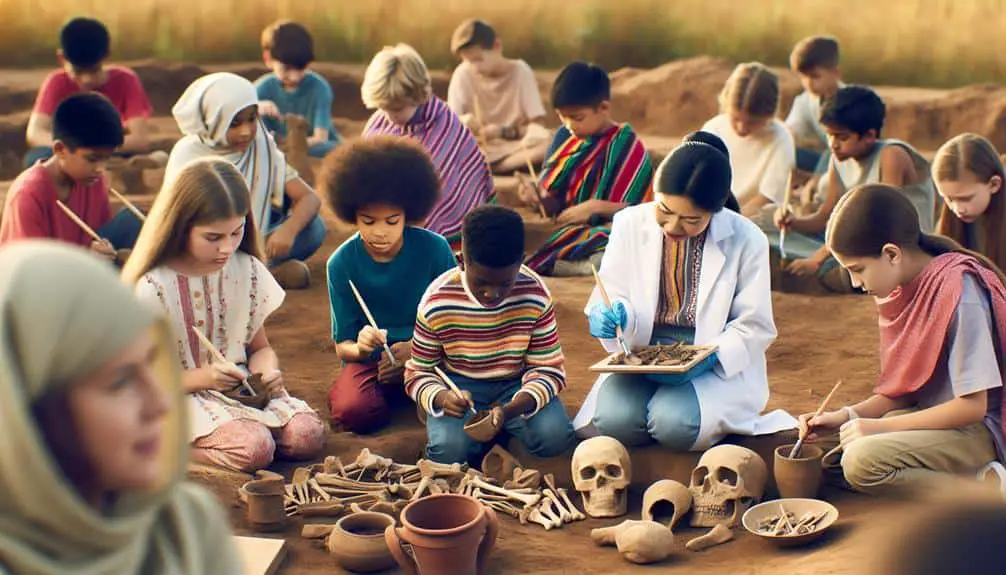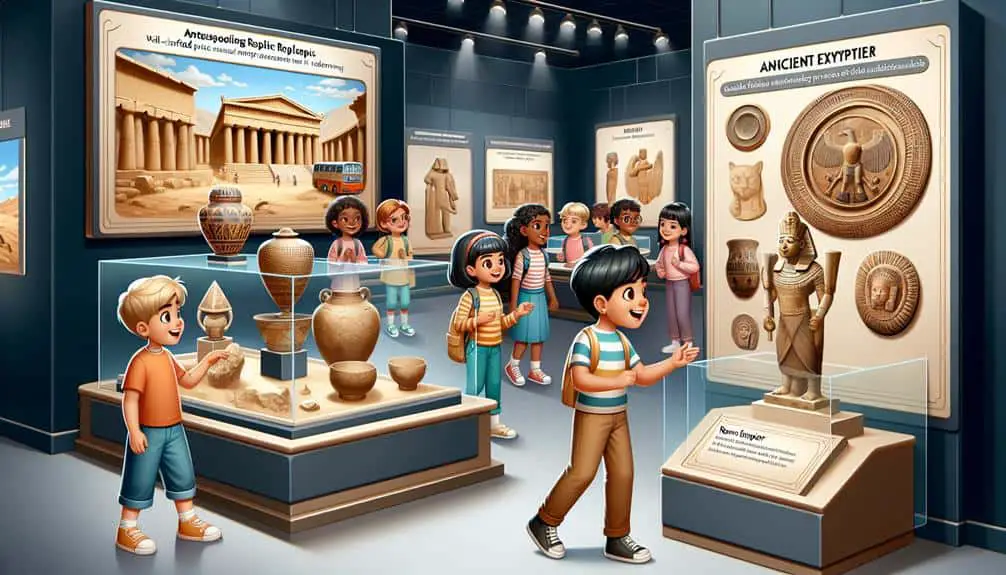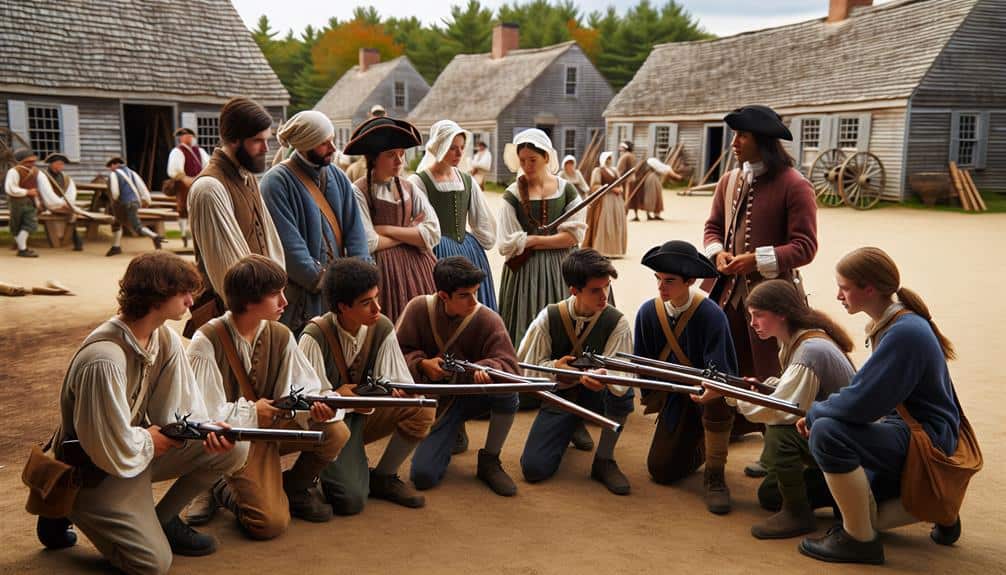Immerse your child in archaeological dig simulations to inspire critical thinking and historical appreciation while having fun. These simulations stimulate curiosity, develop problem-solving skills, and encourage inquiry-based learning. By engaging in hands-on experiences, kids explore the past, enhancing their understanding of historical contexts and fostering teamwork. This interactive approach not only bridges the gap between past civilizations and modern-day competencies but also nurtures essential skills applicable in various aspects of life. Uncover the mysteries of the past while sharpening your child's analytical thinking skills and cultivating a love for history.
Key Points
- Cultivates critical thinking skills and historical understanding.
- Promotes teamwork building and social skills.
- Offers educational fun through interactive explorations.
- Engages children in historical discovery.
- Enhances diverse perspectives and analytical thinking.
Benefits of Archaeological Dig Simulations
Engaging in archaeological dig simulations provides children with hands-on learning experiences that foster critical thinking skills and historical understanding. These interactive explorations offer educational fun by immersing kids in the process of uncovering artifacts and learning about past civilizations. Through these simulations, children engage in historical discovery as they unearth items, analyze their significance, and piece together the puzzle of ancient life.
Moreover, participating in archaeological dig simulations promotes teamwork building among children. By working together to excavate and interpret findings, kids learn the value of collaboration, communication, and shared problem-solving. This collaborative aspect not only enhances their social skills but also reinforces the idea that discoveries in history often require collective effort and diverse perspectives.
In essence, archaeological dig simulations not only provide a platform for interactive exploration and educational fun but also facilitate historical discovery and teamwork building among children. These experiences lay a strong foundation for developing critical thinking skills and fostering a deeper understanding of the past.
Hands-On Learning Experience
To fully grasp the educational benefits of archaeological dig simulations for kids, experiencing a hands-on learning approach is key. Through interactive exploration, children engage in a dynamic educational experience that combines fun with learning. By participating in simulated digs, kids get a taste of what real archaeologists do, fostering a deeper understanding of history and archaeology.
During these simulations, children actively uncover artifacts, analyze findings, and piece together historical contexts. This hands-on learning experience not only cultivates a sense of discovery but also enhances critical thinking skills. By immersing themselves in the process of excavation and interpretation, kids develop a deeper appreciation for the scientific method and historical inquiry.
Moreover, the interactive nature of archaeological dig simulations allows children to learn through play, making education enjoyable and engaging. By combining educational content with entertaining activities, these simulations create a platform for kids to explore, discover, and learn in a way that feels like pure educational fun.
Fostering Curiosity and Critical Thinking
Stimulating curiosity and honing critical thinking skills are fundamental outcomes of engaging in archaeological dig simulations for kids. Through inquiry-based learning, children are encouraged to ask questions, explore possibilities, and problem-solve, mirroring the real-life process of archaeological excavations. This hands-on experience fosters an analytical approach, as young participants learn to evaluate evidence, make connections, and draw conclusions based on their findings.
By delving into the simulated dig sites, children are prompted to think critically about the artifacts they uncover, sparking a sense of wonder and a desire to understand the past. Encouraging exploration, these simulations challenge kids to contemplate various perspectives, analyze data, and develop hypotheses.
As they piece together clues and unravel the mysteries buried beneath the surface, children not only engage with history but also sharpen their analytical thinking skills.
Connecting History With Present-Day Skills
Connecting history with present-day skills involves bridging the gap between past civilizations and contemporary competencies, highlighting the relevance of archaeological dig simulations for kids. Engaging in these simulations not only offers an exciting adventure but also nurtures essential skills that are applicable in various aspects of life. Here's how these activities can help you connect the dots between history and modern-day abilities:
- Critical Analysis: By participating in archaeological dig simulations, you learn to critically analyze artifacts and historical evidence, honing your ability to evaluate information and draw conclusions based on evidence.
- Problem Solving: Unearthing artifacts and interpreting their significance requires problem-solving skills. These simulations challenge you to think creatively, develop hypotheses, and strategize solutions to uncover the mysteries of the past.
- Hands-On Learning: Through hands-on experience, you develop practical skills such as attention to detail, patience, and perseverance, which are invaluable in both historical research and everyday life challenges.
Engaging Alternative to Traditional Field Trips
Engaging in archaeological dig simulations provides a dynamic and immersive alternative to traditional field trips, offering students a hands-on approach to learning about history. These simulations enable interactive learning by allowing students to actively participate in excavations, analyze artifacts, and uncover ancient mysteries in a controlled, educational setting.
By immersing students in the process of excavation and discovery, these simulations create an engaging and memorable experience that goes beyond passive observation.
Compared to traditional field trips where students often observe historical sites from a distance, archaeological dig simulations provide a more immersive experience by allowing them to step into the shoes of archaeologists. This hands-on approach not only fosters a deeper understanding of historical concepts but also cultivates critical thinking, problem-solving skills, and teamwork among students.
The interactive nature of these simulations enhances retention and engagement, making learning about history a truly enriching experience for students of all ages.
Frequently Asked Questions
Are Archaeological Dig Simulations Suitable for All Age Groups?
Archaeological dig simulations cater to all age groups. They offer age-appropriate learning outcomes and engage participants of all ages with hands-on learning experiences. The simulations provide a blend of education and excitement for everyone involved.
How Do These Simulations Cater to Different Learning Styles?
For visual learners, archaeological dig simulations offer hands-on activities that cater to different learning styles. By engaging in excavation tasks and analyzing artifacts, kids can enhance their understanding through practical exploration and observation.
Are There Any Safety Considerations for Children During the Dig?
Are safety precautions necessary during the dig? Yes, indeed. Close supervision is essential to guarantee children's safety. Providing clear instructions, appropriate tools, and a safe environment will make the experience both educational and secure.
What Technology Is Used to Enhance the Simulation Experience?
To enhance the simulation experience, virtual reality technology immerses you in archaeological dig sites virtually. Interactive tools like 3D models, digital reconstructions, and geospatial mapping enable hands-on exploration, fostering a deeper understanding of history and excavation processes.
Can These Simulations Be Customized for Specific Educational Goals?
You can think of customization options in archaeological dig simulations like a paint palette for a masterpiece. These tools enable tailoring experiences to specific educational outcomes, fostering deeper learning and engagement in young archaeologists.



